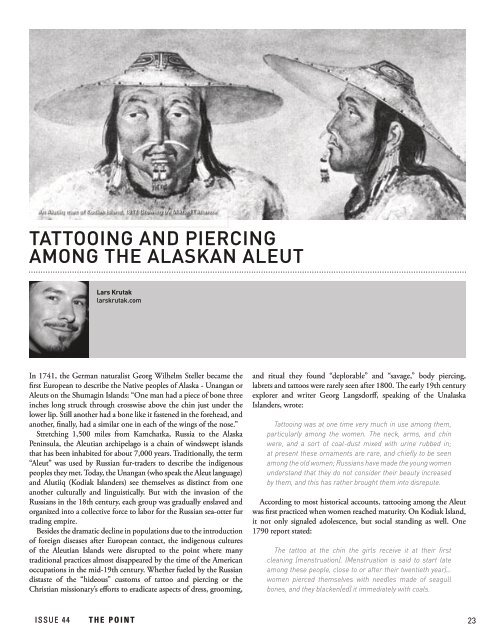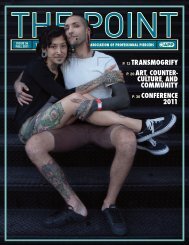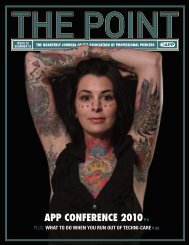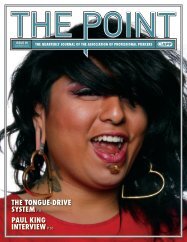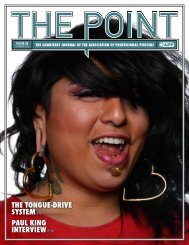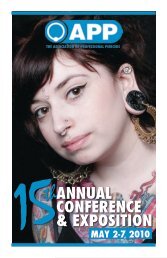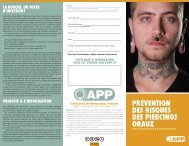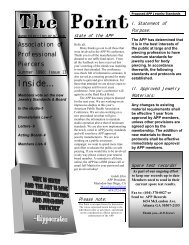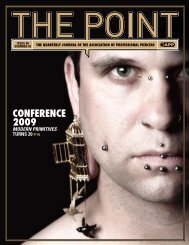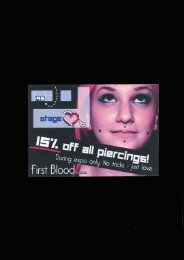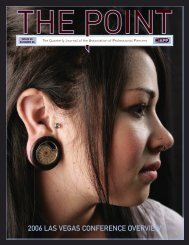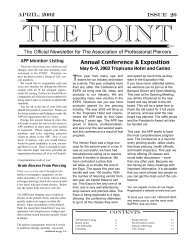The Piercing & tattooing among the aleut the - Association of ...
The Piercing & tattooing among the aleut the - Association of ...
The Piercing & tattooing among the aleut the - Association of ...
Create successful ePaper yourself
Turn your PDF publications into a flip-book with our unique Google optimized e-Paper software.
An Alutiiq man <strong>of</strong> Kodiak Island, 1817. Drawing by Mikhail Tikhanov.<br />
TATTOOING AND PIERCING<br />
AMONG THE ALASKAN ALEUT<br />
Lars Krutak<br />
larskrutak.com<br />
In 1741, <strong>the</strong> German naturalist Georg Wilhelm Steller became <strong>the</strong><br />
first European to describe <strong>the</strong> Native peoples <strong>of</strong> Alaska - Unangan or<br />
Aleuts on <strong>the</strong> Shumagin Islands: “One man had a piece <strong>of</strong> bone three<br />
inches long struck through crosswise above <strong>the</strong> chin just under <strong>the</strong><br />
lower lip. Still ano<strong>the</strong>r had a bone like it fastened in <strong>the</strong> forehead, and<br />
ano<strong>the</strong>r, finally, had a similar one in each <strong>of</strong> <strong>the</strong> wings <strong>of</strong> <strong>the</strong> nose.”<br />
Stretching 1,500 miles from Kamchatka, Russia to <strong>the</strong> Alaska<br />
Peninsula, <strong>the</strong> Aleutian archipelago is a chain <strong>of</strong> windswept islands<br />
that has been inhabited for about 7,000 years. Traditionally, <strong>the</strong> term<br />
“Aleut” was used by Russian fur-traders to describe <strong>the</strong> indigenous<br />
peoples <strong>the</strong>y met. Today, <strong>the</strong> Unangan (who speak <strong>the</strong> Aleut language)<br />
and Alutiiq (Kodiak Islanders) see <strong>the</strong>mselves as distinct from one<br />
ano<strong>the</strong>r culturally and linguistically. But with <strong>the</strong> invasion <strong>of</strong> <strong>the</strong><br />
Russians in <strong>the</strong> 18th century, each group was gradually enslaved and<br />
organized into a collective force to labor for <strong>the</strong> Russian sea-otter fur<br />
trading empire.<br />
Besides <strong>the</strong> dramatic decline in populations due to <strong>the</strong> introduction<br />
<strong>of</strong> foreign diseases after European contact, <strong>the</strong> indigenous cultures<br />
<strong>of</strong> <strong>the</strong> Aleutian Islands were disrupted to <strong>the</strong> point where many<br />
traditional practices almost disappeared by <strong>the</strong> time <strong>of</strong> <strong>the</strong> American<br />
occupations in <strong>the</strong> mid-19th century. Whe<strong>the</strong>r fueled by <strong>the</strong> Russian<br />
distaste <strong>of</strong> <strong>the</strong> “hideous” customs <strong>of</strong> tattoo and piercing or <strong>the</strong><br />
Christian missionary’s efforts to eradicate aspects <strong>of</strong> dress, grooming,<br />
and ritual <strong>the</strong>y found “deplorable” and “savage,” body piercing,<br />
labrets and tattoos were rarely seen after 1800. <strong>The</strong> early 19th century<br />
explorer and writer Georg Langsdorff, speaking <strong>of</strong> <strong>the</strong> Unalaska<br />
Islanders, wrote:<br />
Tattooing was at one time very much in use <strong>among</strong> <strong>the</strong>m,<br />
particularly <strong>among</strong> <strong>the</strong> women. <strong>The</strong> neck, arms, and chin<br />
were, and a sort <strong>of</strong> coal-dust mixed with urine rubbed in;<br />
at present <strong>the</strong>se ornaments are rare, and chiefly to be seen<br />
<strong>among</strong> <strong>the</strong> old women; Russians have made <strong>the</strong> young women<br />
understand that <strong>the</strong>y do not consider <strong>the</strong>ir beauty increased<br />
by <strong>the</strong>m, and this has ra<strong>the</strong>r brought <strong>the</strong>m into disrepute.<br />
According to most historical accounts, <strong>tattooing</strong> <strong>among</strong> <strong>the</strong> Aleut<br />
was first practiced when women reached maturity. On Kodiak Island,<br />
it not only signaled adolescence, but social standing as well. One<br />
1790 report stated:<br />
<strong>The</strong> tattoo at <strong>the</strong> chin <strong>the</strong> girls receive it at <strong>the</strong>ir first<br />
cleaning [menstruation]. (Menstruation is said to start late<br />
<strong>among</strong> <strong>the</strong>se people, close to or after <strong>the</strong>ir twentieth year)…<br />
women pierced <strong>the</strong>mselves with needles made <strong>of</strong> seagull<br />
bones, and <strong>the</strong>y blacken[ed] it immediately with coals.<br />
ISSUE 44 T H E P O I N T 23


